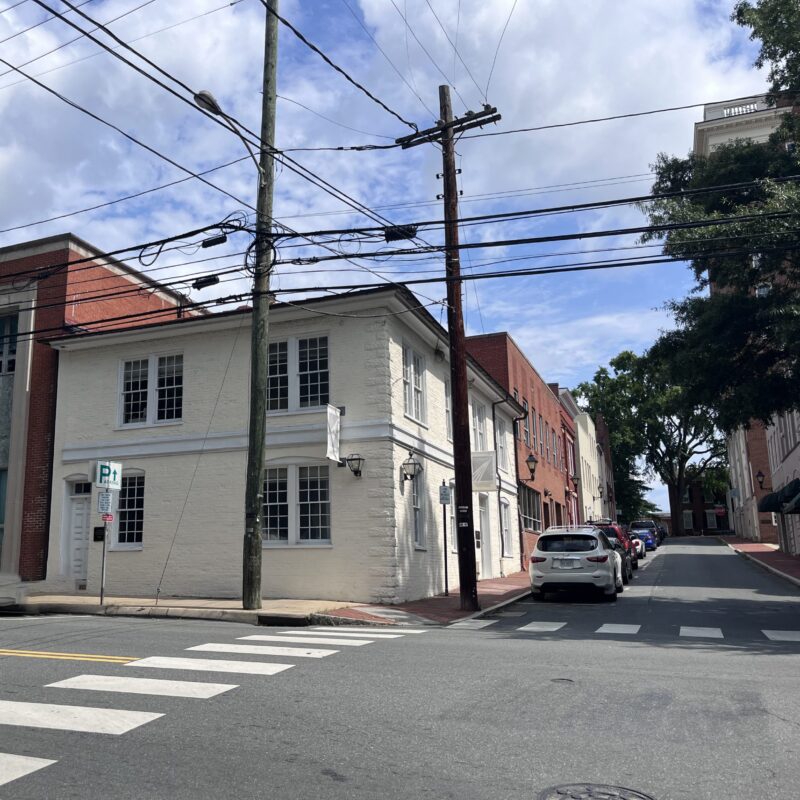 |
| More feature articles:
Function is the new form Rock this town Fresh air Democracy in design |
If there is a tension between traditionalists and modernists around here, they all can make nice with each other at furniture and accessories shop And George. The reclaimed barn on Ivy Road houses a melting pot of designs that range from 19th century French antiques and William Yeoward crystal reproductions to custom-designed, contemporary slate-top coffee tables made by local furniture guy Michael Keith. And that diversity is thanks to the combined efforts of mother-daughter owners Jan Roden (a.k.a. the “traditionalist”) and Christy Ford (a.k.a. the “modernist”).The two seem to have created the perfect place for Charlottesville’s classically leaning population to meet its more cutting-edge cohorts on neutral territory. Yet, Ford and Roden say they didn’t intentionally set out to be the town’s Switzerland of interior design options.
In fact, Roden says, “We didn’t think about the market at all.” Rather, Roden says that she and her daughter were just looking for an opportunity to combine forces—Roden was an interior designer in Northern Virginia and Ford an interior design magazine photographer in New York City—and get back in the same city. Ford had made the decision to move to Charlottesville with her husband, Ryan (who later started the Organic Butcher at the Main Street Market), for a change of lifestyle in 2001, and when she and Roden spotted the old barn shop for sale, they jumped on it and opened And George five weeks later. Roden eventually made Charlottesville her permanent home as well.
 Eero Saarinen meet Louis XVI: Ford pairs a mid-century tulip table with French side chairs from the late 1800s. Antique botanical prints and starburst mirror accompany a sideboard from the ‘40s. |
But even with their familial ties and their obvious eyes for blending eclectic design styles, Roden and Ford initially thought they’d keep their house divided. To furnish the store, they say they each bought what they liked—they still do it that way—and they planned to segregate the shop into rooms they each could furnish in line with their own sensibilities. Roden says, if something felt too modern to her, she’d tell Ford, “You put that in your room.”
Eventually, though, they discovered that they liked the juxtaposition of disparate design elements, the mix of the old and the new. Browsing the store now, it’s difficult to tell where Roden’s traditional influence ends and Ford’s contemporary influence begins. But it’s really no surprise that the store became a blend of classic and contemporary—a style that’s often called “transitional” in design circles. Like many interior designer-types, that’s how Ford and Roden choose to furnish their own homes.
In Ford’s abode, for example, a mid-century tulip table gets a dose of the grandiose with antique dining chairs and a Parsons table gets a taste of the ornate with an antique mirror. Ford says a monochromatic color scheme keeps combinations like these looking cohesive rather than chaotic or clumsy. And Roden says that one of the keys to achieving a classic yet fresh and contemporary look is “to see the usefulness of things.” She likes to take traditionally designed items and antiques and adapt them for contemporary use—she reupholsters 18th century antiques in linen, mohair or kid-friendly tweed, for example, and repaints older wood pieces in bold and more durable lacquers.
 And George offers a blend of classic and contemporary, sometimes on the same piece—here an ebonized black lacquer chair from the ‘40s gets a fresh look with new linen upholstery. Next to that is a Billy Baldwin-style rosewood table. |
So just who is following Ford and Roden’s sophisticated and sundry design lead? Apparently, lots of people—Domino magazine recently recommended And George as one of the best places in the country to buy home accessories. But whether the yokels understand what’s in their own backyards is another story. Roden says that more than half of And George’s clientele is from New York and places outside of town.
The veteran vendor
Another local interior design peddler who, personally speaking, is not a slave to one style or genre is Kenny Ball, owner of Kenny Ball Antiques. Browsing his shop, filled exclusively with 18th and 19th century antiques from continental Europe, you’d think Ball similarly would live in a museum of Louis XV armchairs and George III desks. He too, however, likes to mix things up in his own abode—a 1950s rancher in the Bellair neighborhood. In his dining room for example, mid-century molded-plywood Eames chairs sit astride an antique French empire and a new white laminate table from Ikea plays nicely with antique dining chairs. In his living room, lamps made from the traditional gold tassels of an old theater curtain sit on a clean-lined, mid-century console, which looks similar to something you might find at affordable local vintage store Circa.
 Unlike his traditional antiques store, Kenny Ball’s home décor is an eclectic combination of styles and eras. |
Ball says that his very favorite thing in the house is his quirky, mid-century swivel tub chair that he got for a steal at the Hell’s Kitchen flea market a few years ago. “Others might have reupholstered it, but I kept it covered in its original fabulous and fun, fuzzy orange fabric,” says Ball.
Fuzzy orange fabric does sound like a hoot, but it’s not exactly the type of design that you’d expect the frequenters of his upscale traditional antiques store to appreciate. Those willing to shell out between $1,500 and $3,000 for most of the shop’s pieces (and in one instance, a whopping $15,000 for a French secretary), must take their period pieces pretty darn seriously. Of course, Ball knows that; although, he did find it out the hard way.
Ball started in the home interiors business 20 years ago with a shop called Dovetails next to the C&O Restaurant. At that shop, Ball similarly sold antiques and vintage treasures, but he focused more on large architectural and garden-type metal and stone pieces. At the time, Ball says that such aesthetic was extremely popular in other cities, but that Charlottesville’s “brown furniture people” weren’t ready for it. He closed that business after six years and chose to sell his antiques at road shows around the country for several years before opening up his more traditional antiques shop in the Ivy Road shopping center 10 years ago.
Apparently, Charlottesville also wasn’t ready for Ball’s mid-century modern furniture store called Home, a venture he opened early in 2007 at the Gleason building and closed before the end of the year. Similar to Dovetails, Ball saw vintage modern design as “all the rage everywhere else.” And with the growing number of new condos being developed Downtown and, presumably, the hip, young urbanites with more modern sensibilities and more disposable incomes coming to inhabit them, he says, “We thought let’s do it before someone else does.”
 Roll over rococo: Ball pairs antique French side chairs with a white laminate Ikea table and sets Eames molded-plywood chairs astride an antique French empire. |
Unfortunately, the hip kids either didn’t come, or they came but didn’t bring the cash, or they came with the cash but chose to spend it on newer and cheaper modern fare (at Ikea or Pottery Barn, for instance) or older and cheaper but less name-brandy vintage stuff at Circa. Whatever the reason, Ball says that most of his business at Home came from New Yorkers and other out-of-towners.
Probably not surprisingly, Ball’s traditional antiques business skews slightly more toward the local crowd than Home’s or even And George’s—he says his business is about 60 percent to 40 percent local to nonlocal, but that he also has a significant number of clients from New York City.
Target market
Whether the large percentage of New Yorkers lurking in Charlottesville’s most sophisticated stores is a matter of money or style preferences is a little unclear, but what Ball is able to say is that Charlottesville has come along way in terms of design taste from when he first started out in the business. And despite the failure of Home and the disproportionate amount of out-of-town business at And George, Roden says that the Charlottesville market for interior design includes some pretty refined and “well-traveled” tastes. Through the shop, she’s already reestablished her interior design consulting business and has about 25 local clients on the roster. Of course, Roden also points out that many of those well-traveled folks have chosen to live in Charlottesville not because of its hip new boutiques and increasing cosmopolitanism, but because of “an appreciation for what was already here”—that iconic, classic, colonial country style.





